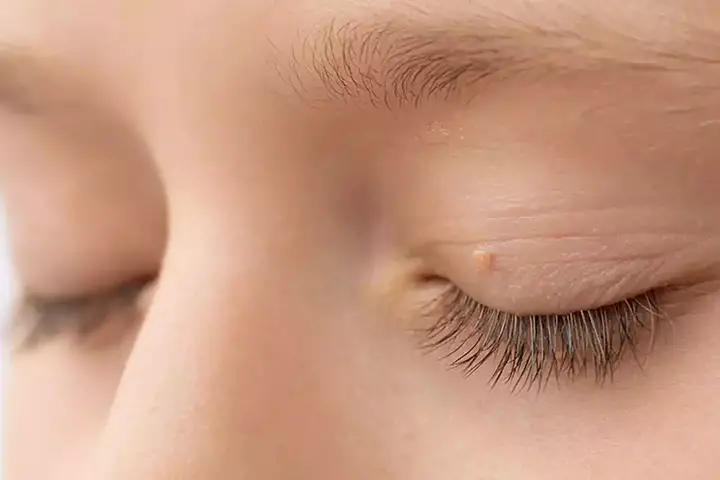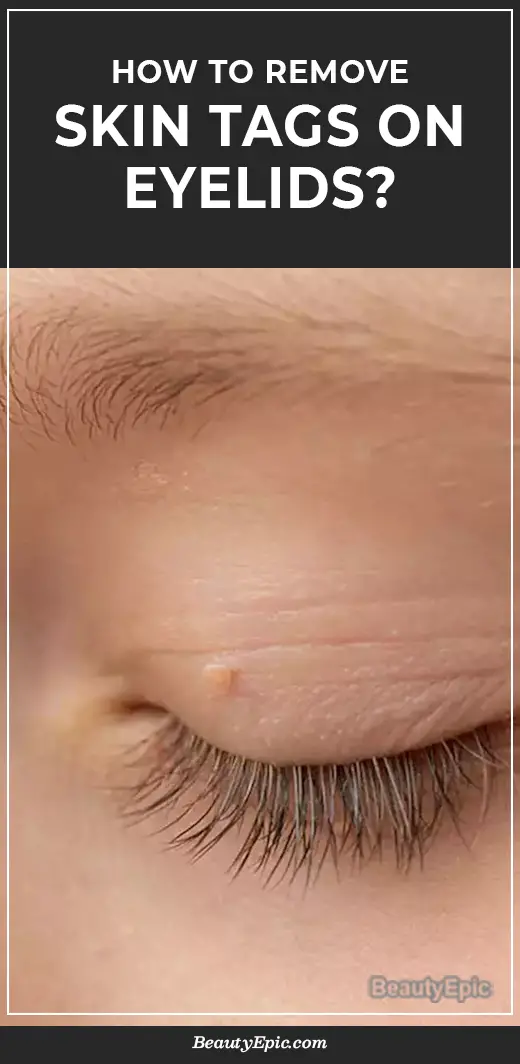
Important: This article is for informational purposes only. Please read our full disclaimer for more details.
Skin tags, medically known as acrochordons, are common benign growths that often appear on areas where the skin folds or experiences friction. These areas include the neck, armpits, and around the eyes.
A skin tag resembles a grouping of regular tissue protruding from a slender stalk. These growths usually vary in size from 1 millimetre (mm) to 5 mm, although larger ones are also possible.
While generally harmless, skin tags on the eyelids can sometimes pose challenges, particularly if they obstruct vision or cause irritation.
This comprehensive guide explores various aspects of skin tags on eyelids, including their removal and underlying causes. We’ll also learn the preventive measures, risk factors, and a few key points one must remember when thinking about how to care for the eyes.
[ Read: How to Remove Skin Tags at Home ]
How to Remove Skin Tags on Eyelids

Removing skin tags is not dangerous, and mild cases do not disturb your eyes’ health. Nevertheless, if a skin tag is blocking the vision or you just don’t like it, taking it off would be a very good idea (1).
Consequently, there are a lot of ways to remove skin tags that can be done at home or by a dermatologist.
Methods of Skin Tag removal depend upon factors like-
- Size of the skin tag
- Location of the skin tag
- Individual choices
Home remedies such as apple cider vinegar or over-the-counter products may provide convenience but can cause irritation, scarring, and infection, especially when applied on sensitive areas like eyelids.
Professional removal by a dermatologist ensures safe and effective treatment with procedures such as:
1. Ligation: The doctor ties a small rubber band around the base of the skin growth to cut off its blood supply. The wart will then die and shed off in due course (2).
2. Cryotherapy: This involves the application of liquid nitrogen to freeze that kill off excess skin growths. Within seven to fourteen days the tag darkens before falling off ultimately.
3. Electrosurgery: The skin tag is destroyed at the base by a probe with an electric current, which gets rid of it very well. It may be employed solely or in combination with other methods (3).
4. Surgical excision: In cases where the skin tags are big and stubborn, surgical intervention is done locally after administering anaesthesia. The dermatologist will make a precision cut using either a surgical scalpel or surgical scissors (4).
Every removal method has been customised to fit each patient’s specific needs and desires so that they achieve the best results while minimising risks and pain.
[ Read: How to Remove Skin Tags Using Apple Cider Vinegar ]
What Causes Skin Tags on Eyelids
The precise cause of skin tags is unknown, but some factors make them more likely to appear on the eyelids. Examples of such causes identified include be:
- Obesity
- Pregnancy
- Age (more common in adults 40 and older)
- Type 2 diabetes
- Hormonal changes
- Genetic predisposition
- Abnormal lipid profile (test to measure cholesterol and other fats in the blood)
- Hypothyroidism
Obese and people with saggy skin may have body parts with folds which is likely to increase the number of skin tags over time (5).
Likewise, hormonal changes in pregnancy can lead to increased numbers of skin tags, although these usually subside after delivery.
It is also believed that about half or even six out of ten adults would develop a skin tag at one time in their lives. Such knowledge helps individuals lower their risks and get assistance when required.
Prevention of Skin Tags Around Eyes
Healthy lifestyles could be the right prevention measure. However, it is not possible to end the risk of exposure to the factors associated with the development of skin tags completely.
You may have been longing for beautiful skin and may have made an attempt to try the best face treatments, but the foundation of healthy skin begins with maintaining a balanced diet, weight management, and control of conditions such as diabetes.
If you witness skin tags surrounding your eyes, call an eye specialist straight away. It’s important for you to check out any lumps located close to your eyes. Regular eye checkups are also vital for detecting any abnormalities early, including the skin tags around your eyes.
It is noteworthy that timely intervention and forehand control can avoid skin tags around the eyes.
Risk Factors
Certain demographic and health-related factors increase susceptibility to skin tags, especially on the eyelids. Below are the risk factors that may contribute to skin tags-
- Age
- Overweightness
- Diabetes
- Impaired hormonal function
- Hereditary diseases
Conclusion
Skin tags at the lids of the eyes are dermatological issues usually being evaluated and treated individually. By comprehending the means of exertion and the root leading causes, you can manage the best possible eye health. Also, you can make informed decisions regarding the treatment once the risk factors are known.
Consulting from a dermatologist throws a light on what is to be done and how, making removal as safe and effective as possible and minimising risks of going just wrong. With proper care and attention, an individual can take care of his/her skin tag under the eye with confidence and keep the eyes healthy for the future.
You Might Also Like
- How to Remove Skin Tags with Tea Tree Oil
- How to Use Baking Soda and Castor Oil for Skin Tag Removal
- How to Apply Eye Shadow by Eye Shape?
- 7 Best Eye Creams For Droopy Upper Eyelids
















